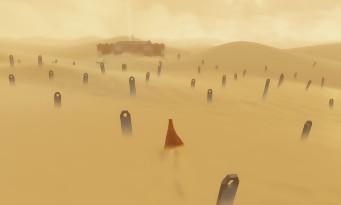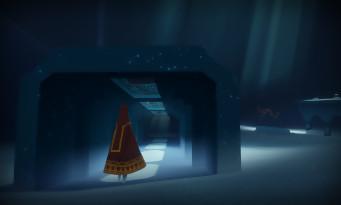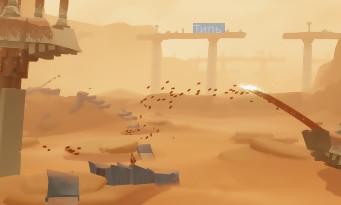 As much to tell you right away, Journey has benefited from a single modification in three years, a total overhaul of its graphics. But what a transformation! By switching to 1080p 60fps, the game reaches a technical beauty that finally sticks to what the adventure offered us. Always faithful to this simplicity so appreciated on PS3, Journey nevertheless manages to densify its appearance without adding frills, even offering an unfailing sense of detail. Every grain of desert sand crossed could be counted, the golden reflections on the dunes would almost make us want to jump in and lie down. The final shots are also resplendent with beauty and depth, letting the sun reflect softly on the snow. The darker settings are not left out, the snowstorm giving us shivers at the sight of our little frozen red character. But just as beautiful as it is, Journey still suffers from a big problem: the lack of interaction with the gigantic world that is offered to our view. We find ourselves sliding and jumping throughout the adventure, contenting ourselves with following an almost straight line that seems all drawn, when we deserve at least the time for a moment to get lost in the immensity unoccupied with a seemingly open world. The impression of crossing (wandering slowly) a succession of levels, without being able to do anything except enjoy, is still a little frustrating and feeds the idea that Journey has no story to speak of. , except that of making you reach the state of light by freeing you from who knows what.
As much to tell you right away, Journey has benefited from a single modification in three years, a total overhaul of its graphics. But what a transformation! By switching to 1080p 60fps, the game reaches a technical beauty that finally sticks to what the adventure offered us. Always faithful to this simplicity so appreciated on PS3, Journey nevertheless manages to densify its appearance without adding frills, even offering an unfailing sense of detail. Every grain of desert sand crossed could be counted, the golden reflections on the dunes would almost make us want to jump in and lie down. The final shots are also resplendent with beauty and depth, letting the sun reflect softly on the snow. The darker settings are not left out, the snowstorm giving us shivers at the sight of our little frozen red character. But just as beautiful as it is, Journey still suffers from a big problem: the lack of interaction with the gigantic world that is offered to our view. We find ourselves sliding and jumping throughout the adventure, contenting ourselves with following an almost straight line that seems all drawn, when we deserve at least the time for a moment to get lost in the immensity unoccupied with a seemingly open world. The impression of crossing (wandering slowly) a succession of levels, without being able to do anything except enjoy, is still a little frustrating and feeds the idea that Journey has no story to speak of. , except that of making you reach the state of light by freeing you from who knows what.
WHEN YOU'RE IN THE DESERT, NOT LONG ENOUGH
 And in this inner journey, you are outdoors a duo, a completely random player joining you and not leaving you until the finish is reached. The classic "One is good, two is better". But now, two, it's actually not really better. Without any real interaction, apart from the sounds made by the characters, having someone by your side is useless. Sometimes we even wish it would disappear, leaving us to enjoy the landscapes and the atmosphere all by ourselves. Fortunately, it is possible to leave it by continuing our way, without stopping, and thus once again let yourself be carried away by the air and the planing and melancholy musical atmosphere of Journey. Because yes, one of the great strengths of contemplative games generally lies in the sound environment, which is often calm and refined. In this area, Journey definitely masters its subject, the music passing directly from the ears to the heart. As a whole, the experience of thatgamecompany is certainly one of the most beautiful of the PS4, and the graphic improvement allows us to experience this magnificent again, transporting us again with ease to the universe already admired on PS3.
And in this inner journey, you are outdoors a duo, a completely random player joining you and not leaving you until the finish is reached. The classic "One is good, two is better". But now, two, it's actually not really better. Without any real interaction, apart from the sounds made by the characters, having someone by your side is useless. Sometimes we even wish it would disappear, leaving us to enjoy the landscapes and the atmosphere all by ourselves. Fortunately, it is possible to leave it by continuing our way, without stopping, and thus once again let yourself be carried away by the air and the planing and melancholy musical atmosphere of Journey. Because yes, one of the great strengths of contemplative games generally lies in the sound environment, which is often calm and refined. In this area, Journey definitely masters its subject, the music passing directly from the ears to the heart. As a whole, the experience of thatgamecompany is certainly one of the most beautiful of the PS4, and the graphic improvement allows us to experience this magnificent again, transporting us again with ease to the universe already admired on PS3.
 A short solitary and rhythmic walk, Journey is a Buddhist excursion during which the little character you play will seek his independence by wishing to get rid of all material possessions, the latter being symbolized by the scarf around his neck, which grows the more he progresses, and shrinks as the long-sought goal draws near. In vast uncluttered spaces, it is then a quest towards an unattractive inner "me" that opens up. And yet in a world as important as that of Journey, thatgamecompany manages to guide us perfectly where we need to go, letting the player's intuition act as a guideline. An immersive feeling that can only be felt in the event of sensitivity developed in the player, which represents a challenge. Colorful and languid, Journey is PS4's prettiest ride, an experience worth taking the time to experience at least once. But it must be recognized that the absence of a scenario combined with the very short lifespan of the game will surely not encourage those looking for an advanced adventure.
A short solitary and rhythmic walk, Journey is a Buddhist excursion during which the little character you play will seek his independence by wishing to get rid of all material possessions, the latter being symbolized by the scarf around his neck, which grows the more he progresses, and shrinks as the long-sought goal draws near. In vast uncluttered spaces, it is then a quest towards an unattractive inner "me" that opens up. And yet in a world as important as that of Journey, thatgamecompany manages to guide us perfectly where we need to go, letting the player's intuition act as a guideline. An immersive feeling that can only be felt in the event of sensitivity developed in the player, which represents a challenge. Colorful and languid, Journey is PS4's prettiest ride, an experience worth taking the time to experience at least once. But it must be recognized that the absence of a scenario combined with the very short lifespan of the game will surely not encourage those looking for an advanced adventure.


























